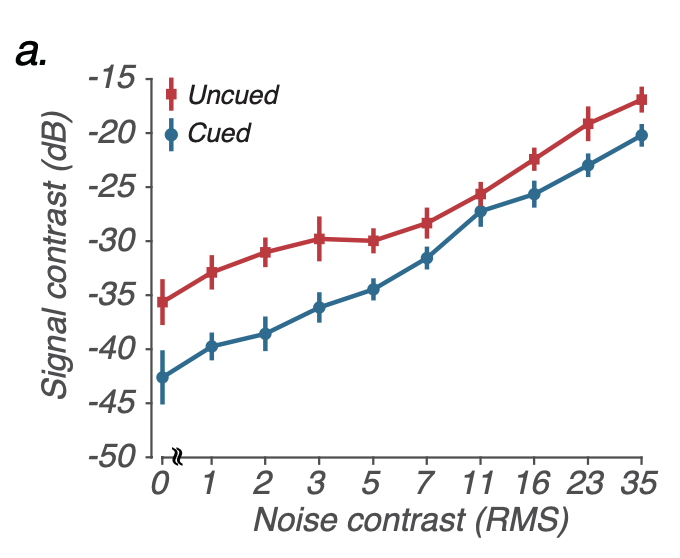Temporal attention selectively enhances target features
Journal of Vision (2021)
Luis Ramirez, Joshua Foster & Sam Ling
 Temporal attention, the allocation of attention to a moment in time, improves perception. Here, we examined the computational mechanism by which temporal attention improves perception, under a divisive normalization framework. Under this framework, attention can improve perception of a target signal in three ways: stimulus enhancement (increasing gain across all sensory channels), signal enhancement (selectively increasing gain in channels that encode the target stimulus), or external noise exclusion (reducing the gain in channels that encode irrelevant features). These mechanisms make diverging predictions when a target is embedded in varying levels of noise: stimulus enhancement improves performance only when noise is low, signal enhancement improves performance at all noise intensities, and external noise exclusion improves performance only when noise is high. To date, temporal attention studies have used noise-free displays. Therefore, it is unclear whether temporal attention acts via stimulus enhancement (amplifying both target features and noise) or signal enhancement (selectively amplifying target features) because both mechanisms predict improved performance in the absence of noise. To tease these mechanisms apart, we manipulated temporal attention using an auditory cue while parametrically varying external noise in a fine-orientation discrimination task. Temporal attention improved perceptual thresholds across all noise levels. Formal model comparisons revealed that this cuing effect was best accounted for by a combination of signal enhancement and stimulus enhancement, suggesting that temporal attention improves perceptual
Temporal attention, the allocation of attention to a moment in time, improves perception. Here, we examined the computational mechanism by which temporal attention improves perception, under a divisive normalization framework. Under this framework, attention can improve perception of a target signal in three ways: stimulus enhancement (increasing gain across all sensory channels), signal enhancement (selectively increasing gain in channels that encode the target stimulus), or external noise exclusion (reducing the gain in channels that encode irrelevant features). These mechanisms make diverging predictions when a target is embedded in varying levels of noise: stimulus enhancement improves performance only when noise is low, signal enhancement improves performance at all noise intensities, and external noise exclusion improves performance only when noise is high. To date, temporal attention studies have used noise-free displays. Therefore, it is unclear whether temporal attention acts via stimulus enhancement (amplifying both target features and noise) or signal enhancement (selectively amplifying target features) because both mechanisms predict improved performance in the absence of noise. To tease these mechanisms apart, we manipulated temporal attention using an auditory cue while parametrically varying external noise in a fine-orientation discrimination task. Temporal attention improved perceptual thresholds across all noise levels. Formal model comparisons revealed that this cuing effect was best accounted for by a combination of signal enhancement and stimulus enhancement, suggesting that temporal attention improves perceptual

